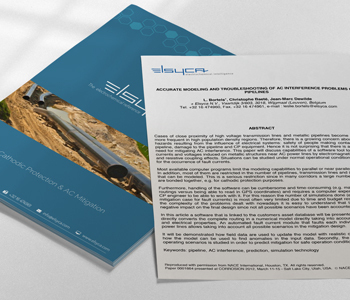
Accurate Modelling and Troubleshooting of AC Interference Problems on Pipelines
(NACE 2012)
Troubleshooting of AC interference problems on pipelines

Accurate Modelling and Troubleshouting of AC Interference Problems on Pipelines (NACE 2012)
Leslie Bortels, Christophe Baeté, Jean-Marc Dewilde, Elsyca n.v.
Abstract
Cases of close proximity of high voltage transmission lines and metallic pipelines become more and more frequent in high population density regions. Therefore, there is a growing concern about possible hazards resulting from the influence of electrical systems: safety of people making contact with the pipeline, damage to the pipeline and CP equipment. Hence it is not surprising that there is an industrial need for mitigating AC interference. This paper will discuss capabilities of a software tool to predict AC currents and voltages induced on metallic structures near AC power lines by electromagnetic induction, and resistive coupling effects. Situations can be studied under normal operational conditions as well as for the occurrence of fault currents.
Most available computer programs limit the modeling capabilities to parallel or near parallel geometries. In addition, most of them are restricted in the number of pipelines, transmission lines and (direct) bonds that can be modeled. This is a serious restriction since in many corridors a large number of pipelines are bonded together, e.g. for cathodic protection purposes.
Furthermore, handling of the software can be cumbersome and time-consuming (e.g. manual adding of routings versus being able to read in GPS coordinates) and requires a computer expert rather than a CP engineer to be able to work with it. For this reason, the number of simulations done (especially in the mitigation case for fault currents) is most often very limited due to time and budget restrictions. Given the complexity of the problems dealt with nowadays it is easy to understand that this can have a negative impact on the final design since not all possible scenarios have been accounted for.
In this article a software that is linked to the customers asset database will be presented. The software directly converts the complete routing in a numerical model directly taking into account all geometrical and electrical properties. An automated fault current module that faults each individual tower of all power lines allows taking into account all possible scenarios in the mitigation design.
It will be demonstrated how field data are used to update the model with realistic coating values and how the model can be used to find anomalies in the input data. Secondly, the effect of different operating scenarios is studied in order to predict mitigation for safe operation conditions.
Download pdf